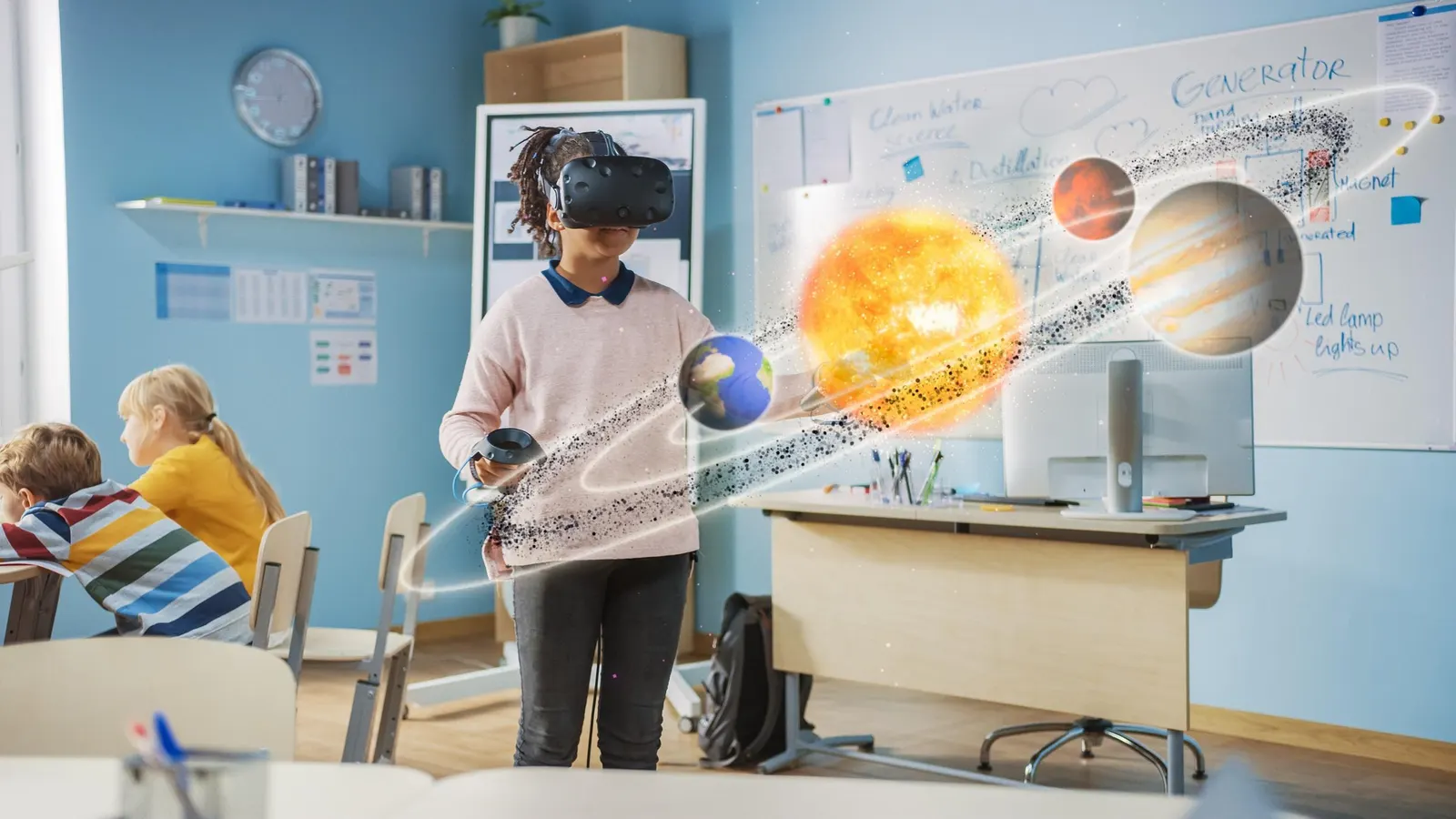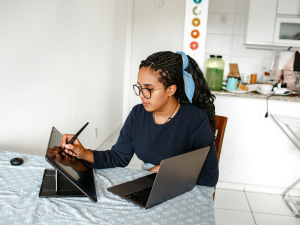For years, classrooms have relied on the same tools: textbooks, chalkboards, and lectures. But learning is no longer limited to what’s written on a page or projected on a screen. With Augmented Reality (AR) and Virtual Reality (VR), lessons are breaking free from the flat world of books and entering a space where students can see, move, and interact with knowledge.
AR and VR turn imagination into experience. Augmented Reality adds digital layers to the real world, such as seeing a beating 3D heart float above a biology textbook. Virtual Reality goes a step further, placing students inside entirely new environments, such as a chemistry lab, an ancient civilisation, or even outer space.
This isn’t just about making lessons look cool. It’s about transforming how students understand concepts. A history class where you walk through ancient Rome, a physics lesson where you manipulate gravity, or a medical course where you perform virtual surgery learning suddenly feels alive.
AR and VR are helping schools and universities create what’s often missing from traditional education: immersion. When students can experience what they’re learning, understanding becomes natural and curiosity follows automatically.
And this isn’t some far-off dream. Around the world, classrooms are already using these tools to make complex subjects simple, safe, and deeply engaging.
Let’s explore how these virtual layers are reshaping learning one subject at a time.
What Makes AR and VR So Powerful in Classrooms?
There’s a simple reason AR and VR are gaining ground in education: they make learning feel real. For students who’ve grown up surrounded by screens, videos, and games, sitting through lectures can feel distant. But when those same students can step inside a concept, interact with it, and see how it works, learning instantly becomes more meaningful.
Augmented Reality (AR) and Virtual Reality (VR) do this in two different but equally powerful ways.
- AR adds a digital layer to the real world. Imagine pointing your tablet at a picture of the solar system and watching the planets start orbiting right in front of you.
- VR, on the other hand, creates a completely new environment. Slip on a headset, and you could find yourself inside a rainforest, a chemistry lab, or even the human bloodstream.
These technologies work best when combined with good teaching. AR helps bridge the gap between theory and application, giving students instant visual context. VR then deepens that understanding by creating an environment where they can practice what they’ve learned — without limits or risk.
And this goes beyond flashy visuals. AR and VR cater to different learning styles. Visual learners benefit from 3D models; hands-on learners get to interact with virtual tools; and auditory learners can absorb information through narrated simulations. Everyone gets to learn in a way that suits them best.
That’s what makes these technologies transformative: they don’t replace education; they amplify it. They make abstract concepts tangible and learning experiences unforgettable.
Now, let’s see how these tools are already revolutionising specific subjects, starting with one where curiosity and experimentation have always been key: science.
How Are AR and VR Transforming Science Classrooms?
They’re turning science from something students read about into something they can experience. With AR and VR, experiments, models, and theories come alive in ways a traditional classroom can’t match.
In virtual labs, students can perform chemistry experiments, test hypotheses, and explore microscopic worlds without safety concerns or limited lab supplies. They can manipulate molecules, mix virtual chemicals, or simulate gravity through trial, error, and curiosity.
AR, on the other hand, adds another layer to physical textbooks and classrooms. A simple tablet or smartphone can project 3D models right on a desk, a rotating atom, the water cycle in motion, or even a detailed view of the solar system. This helps students visualise processes that are otherwise hard to grasp, like molecular bonding or cell division.
This kind of visual and interactive learning doesn’t just make science more interesting; it makes it more memorable. Students remember what they do, not just what they read. Teachers can focus less on explaining and more on guiding exploration, turning every class into a hands-on experience.
When students start seeing science unfold in front of them, curiosity takes over. And that’s where real learning begins.
How Are AR and VR Transforming IT and Tech Education?
They’re bridging the gap between theory and real-world application, giving tech students a way to build, test, and visualise complex systems before they ever write a single line of production code, in fields like artificial intelligence, cybersecurity, data science, or networking, where hands-on practice matters as much as knowledge, AR and VR turn abstract concepts into immersive, practical experiences.
In AI and machine learning courses, for instance, VR environments can simulate data-driven decision-making in real time. Students can watch algorithms “learn” and adapt in a 3D visual space—seeing how parameters, datasets, and neural networks interact beneath the surface. It’s one thing to code a model in Python; it’s another to step inside it and see how every node communicates.
In cybersecurity, VR can replicate full-scale network infrastructures for penetration testing, incident response, and ethical hacking simulations all within a safe, contained environment. Students can defend virtual systems against live attack scenarios, making training both practical and risk-free.
AR, meanwhile, enhances classroom instruction by overlaying interactive visuals on top of physical setups. A networking instructor, for example, could use AR to show live data flows across routers and switches, or a cloud computing class could visualise server architecture and data migration in 3D. These overlays make complex processes instantly understandable.
For engineering and robotics, AR and VR are closely integrated with prototyping. Students can design, assemble, and test virtual models before committing to physical builds, saving both cost and time. And when integrated with AI, these systems can provide real-time feedback on efficiency, errors, or alternative solutions just like a human mentor would.
In short, AR and VR turn IT and tech education from screen-based learning into experience-based learning. Students don’t just study code or systems; they interact with them, explore them, and understand how they behave in dynamic, simulated environments.
What Are the Key Benefits of Using AR and VR in Tech Education?
They make learning feel less like instruction and more like exploration. Instead of reading slides or memorising theory, students can dive into digital environments where they learn by doing, testing, and experiencing. This shift from passive to active learning changes everything from how quickly students grasp concepts to how confidently they apply them later.
First, engagement skyrockets. When students can manipulate virtual components, walk through simulated systems, or visualise data in 3D, their focus naturally deepens. Lessons that might feel abstract on paper suddenly become hands-on, sparking curiosity and long-term retention.
Second, comprehension improves. AR and VR transform complex topics, such as network design, programming logic, and system architecture, into interactive visuals. Complex ideas become stories students can navigate, helping them connect the dots faster and remember details longer.
Third, practice becomes safer and more accessible. Simulated environments allow trial and error without consequences. Students can repeat tasks, test theories, and make mistakes freely, which is crucial for developing confidence and real-world problem-solving skills.
Fourth, inclusivity grows. Not every learner absorbs information the same way. AR and VR make education more adaptable by supporting multiple learning styles, visual, auditory, and kinesthetic, ensuring no one gets left behind.
And finally, motivation strengthens. The instant feedback, rewards, and sense of progress these tools create mirror the gaming systems students already enjoy. The result? A genuine drive to learn, not just to pass.
When learning becomes this immersive, the line between study and experience fades, and that’s exactly what makes it powerful.
How Do AR and VR Personalise Learning Experiences?
They adapt to each learner’s pace, style, and progress, something even the best traditional classrooms struggle to achieve. Instead of teaching everyone the same way, AR and VR let students explore, practice, and master concepts at their own speed.
A virtual classroom powered by these tools can track how a learner interacts with the material, how long they spend on a task, where they struggle, and what engages them most. Based on this data, the system adjusts automatically. If someone finds a topic challenging, it offers more hints, simplified visuals, or extra exercises. For students who grasp it quickly, it unlocks advanced challenges or new layers of complexity.
This kind of adaptive learning means every student gets exactly what they need when they need it. No waiting for the class to catch up, no feeling left behind. Just continuous, personalised growth.
Augmented Reality enhances this further by layering guidance right into the learner’s environment. For instance, when working on a virtual circuit or design, AR can highlight errors in real time, point out alternative approaches, or show step-by-step instructions as holographic overlays.
For educators, the data behind all this personalisation is equally valuable. Teachers can identify patterns of those who are excelling, those who are struggling, and where the course needs improvement, and adjust lessons accordingly. It transforms classrooms from “one-size-fits-all” setups into dynamic ecosystems where every student’s journey is unique and optimised.
In the simplest terms, AR and VR make learning personal again, shifting the focus from instruction to connection and understanding.
What Challenges Come with Integrating AR and VR in Education?
As promising as AR and VR sound, bringing them into classrooms isn’t as simple as plugging in a headset. These technologies demand more than excitement; they need planning, training, and thoughtful execution to work truly.
The first challenge is cost. High-quality VR headsets, compatible computers, and specialised software can be expensive. For schools and universities with tight budgets, this makes large-scale implementation difficult. Even though prices are dropping, creating equitable access for all students remains a hurdle.
Then there’s the issue of teacher training. Many educators are still getting comfortable with digital tools, let alone immersive tech. Without proper guidance, AR and VR can easily become flashy distractions rather than meaningful learning tools. Institutions should invest in professional development that enables teachers to integrate these experiences into their lessons seamlessly.
Content creation poses another challenge. Developing high-quality, curriculum-aligned AR and VR material takes time, skill, and resources. While some platforms offer pre-built modules, teachers often need to adapt or build their own to fit specific learning goals.
Technical limitations, such as bandwidth issues, motion sickness, or hardware compatibility, can also affect classroom adoption. A single glitch can disrupt the immersive flow that makes these tools effective in the first place.
And finally, there’s the digital divide. Not every student has access to reliable internet or updated devices at home. As education becomes more tech-driven, schools must ensure that immersive learning doesn’t leave behind the very students it’s meant to empower.
Despite these barriers, the momentum behind AR and VR in education keeps growing. With every innovation, these challenges become a little easier to overcome—and the promise of truly immersive, inclusive learning gets closer to reality.
How Will AR and VR Shape the Future of Learning?
They’re paving the way for an education system that feels less like memorisation and more like discovery. As AR and VR continue to evolve, they’re not just adding new tools to classrooms; they’re redefining what learning means altogether.
In the near future, these technologies will make global collaboration and hands-on learning accessible to anyone, anywhere. Students in different countries will be able to share a virtual classroom, work on the same project, and interact with 3D data or simulations as if they were sitting side by side.
Imagine studying environmental science and standing inside a virtual rainforest while analysing live climate data or exploring the architecture of ancient civilisations by walking through digital reconstructions. Lessons will no longer be bound by geography, cost, or physical limitations.
AI will amplify this transformation. Intelligent systems will analyse student behaviour in AR/VR environments and provide deeper personalisation, adjusting difficulty levels, tracking progress, and offering tailored feedback. Teachers will have access to rich insights on how each learner absorbs information, making education more adaptive and humane.
As technology and pedagogy continue to merge, classrooms will become ecosystems of exploration where curiosity drives progress, and every student learns not by instruction but by experience.
It’s not about replacing teachers or traditional learning; it’s about giving them new dimensions to work with. The future classroom won’t just teach knowledge, it will immerse students in it.
Conclusion: The Classroom Is No Longer Flat
AR and VR are no longer futuristic add-ons; they represent the next step in how we learn, explore, and understand. They turn lessons into journeys and information into experience. When students can walk inside a simulation, manipulate virtual objects, and see the direct impact of their decisions, learning becomes active, personal, and deeply memorable.
Of course, challenges like cost, training, and accessibility remain. But with growing innovation and investment, these barriers are shrinking fast. The real question now isn’t if immersive learning will become standard, it’s when.
As AR and VR continue to evolve, education won’t just be about transferring knowledge; it’ll be about building curiosity, creativity, and confidence in every learner. The blackboard may fade, but the possibilities? They’re only getting bigger.
FAQs: Clearing Up Common Questions
1. What is the use of virtual reality and augmented reality in education?
VR and AR help students learn through immersive experiences. Instead of reading or watching, they can explore and interact, making complex ideas easier to grasp and remember.
2. How does virtual reality enhance science and technology education?
VR lets students conduct experiments or simulations safely and repeatedly. It turns abstract theories into practical experiences, improving both understanding and retention.
3. How is augmented reality used in classrooms?
AR overlays digital visuals, such as 3D models or instructions, onto the real world. Teachers use it to explain concepts visually, and students use it to explore lessons interactively.
4. What are the main benefits of using AR and VR for learning?
They increase engagement, improve comprehension, allow safe experimentation, and make lessons adaptable to each student’s pace and learning style.
5. What’s next for AR and VR in education?
Future classrooms will combine AR, VR, and AI to create personalised, borderless learning environments. Students will collaborate in shared digital spaces that feel just as real as physical ones.






